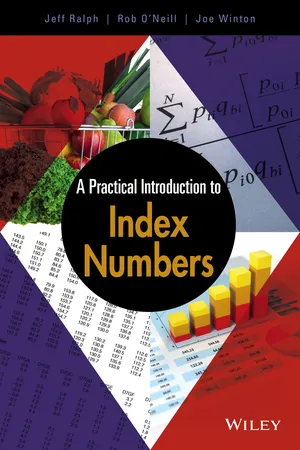
- English
- ePUB (mobile friendly)
- Available on iOS & Android
A Practical Introduction to Index Numbers
About This Book
This book provides an introduction to index numbers for statisticians, economists and numerate members of the public. It covers the essential basics, mixing theoretical aspects with practical techniques to give a balanced and accessible introduction to the subject. The concepts are illustrated by exploring the construction and use of the Consumer Prices Index which is arguably the most important of all official statistics in the UK. The book also considers current issues and developments in the field including the use of large-scale price transaction data.
A Practical Introduction to Index Numbers will be the ideal accompaniment for students taking the index number components of the Royal Statistical Society Ordinary and Higher Certificate exams; it provides suggested routes through the book for students, and sets of exercises with solutions.
Frequently asked questions
Information
Chapter 1
Introduction
1.1 What is an index number?
| Value of retail sales (£bn) | Value relative to sales in 2005 (2005 = 100) | |
| 2005 | 281.450 | 100.00 |
| 2006 | 292.110 | 103.79 |
| 2007 | 303.621 | 107.88 |
| 2008 | 321.178 | 114.12 |
1.2 Example – the Consumer Prices Index
| Index (UK, 2005 = 100) | 1-Month rate | 12-Month rate | ||
| 2012 | Sep | 123.5 | 0.4 | 2.2 |
| Oct | 124.2 | 0.5 | 2.7 | |
| Nov | 124.4 | 0.2 | 2.7 | |
| Dec | 125.0 | 0.5 | 2.7 | |
| 2013 | Jan | 124.4 | −0.5 | 2.7 |
| Feb | 125.2 | 0.7 | 2.8 | |
| Mar | 125.6 | 0.3 | 2.8 | |
| Apr | 125.9 | 0.2 | 2.4 | |
| May | 126.1 | 0.2 | 2.7 | |
| Jun | 125.9 | −0.2 | 2.9 | |
| Jul | 125.8 | 0.0 | 2.8 | |
| Aug | 126.4 | 0.4 | 2.7 | |
| Sep | 126.8 | 0.4 | 2.7 |
Table of contents
- Cover
- Title Page
- Copyright
- Table of Contents
- Preface
- Acknowledgements
- Chapter 1: Introduction
- Chapter 2: Index numbers and change
- Chapter 3: Measuring inflation
- Chapter 4: Introducing price and quantity
- Chapter 5: Laspeyres and Paasche indices
- Chapter 6: Domains and aggregation
- Chapter 7: Linking and chain-linking
- Chapter 8: Constructing the consumer prices index
- Chapter 9: Re-referencing a series
- Chapter 10: Deflation
- Chapter 11: Price and quantity index numbers in practice
- Chapter 12: Further index formulae
- Chapter 13: The choice of index formula
- Chapter 14: Issues in index numbers
- Chapter 15: Research topics in index numbers
- Appendix A: Mathematics for index numbers
- Appendix B: Choice of index formula
- Appendix C: Glossary of terms and formulas
- Appendix D: Solutions to exercises
- Appendix E: Further reading
- Index
- End User License Agreement